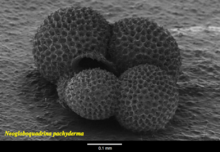Globigerinida
| Globigerinida | ||||||||||||
|---|---|---|---|---|---|---|---|---|---|---|---|---|
| Systematics | ||||||||||||
|
||||||||||||
| Scientific name | ||||||||||||
| Globigerinida | ||||||||||||
| Delage & Hérouard , 1896 |

Globigerinida is a single- celled taxon from the group of foraminifera . Ballentierchen is an outdated German term . It is the only group of foraminifera whose species live planktonically .
features
Almost all species form housings from calcite, which in all recent species have a very low magnesium content (low magnesium calcite ), only in some fossil species is high magnesium calcite (> 5 mol% Mg) detected. The cases of the fossil Favusellacea , which consisted of aragonite , are an exception . The wall of the housing is interspersed with numerous pores that are significantly larger than in benthic species and have a bilamellar structure, i.e. the cell substance is found between an inner and an outer wall. The chambers of the calcareous shell, which are almost circular in elevation, are arranged in a spiral (trochospiral, planispiral) or in rows.
In addition to the Miliolida and the Rotaliida , the Globigerinida are one of the three foraminifera groups that serve as hosts for photosynthesizing endosymbionts . Such symbioses are the rule with the planktonic and thus close to light Globigerinida than with the other groups. The endosymbionts are dinoflagellates or golden brown algae .
paleontology
Globigerinida are an important part of zooplankton worldwide. Their shells sink after their death, collect on the sea floor and form one of the most common marine sediments, the so-called “ globigerin silt ”. In the course of geological processes, sediments are formed, which are of great importance in paleontology for stratigraphic analysis. Due to the extremely frequent finds, their evolution has been extremely well researched since the Miocene.
All seven recent subgroups have been found in fossil form since the Miocene , the Guembelitriidae since the Cretaceous . Their evolutionary origin, however, is insufficiently known; they may have emerged from the Oberhauserellidae around 180 million years ago .
Systematics
The group is currently structured as follows:
- Heterohelicacea
- Globorotaliacea
- Globigerinacea
Both their position within the foraminifera and the internal systematics of the globigerinida are based on purely morphological features. Initial molecular genetic investigations using rRNA resulted in hardly meaningful results, since the exchange rate of non-coding bases in globigerinida is around fifty to 100 times as high as in benthic foraminifera, but indicated a proximity to the Rotaliida . Later phylogenetic studies using actin confirmed this, where the Globeriginida were found as a sister taxon of a Rotaliida, which indicates that the Globigerinida are part of the Rotaliida. However, further investigations are required for a final classification.
mineral
Globigerin limestone is mined in Malta as an ocher-colored sand-lime brick . Typically houses on this island are built from this building material and appear yellowish.
As quicklime or slaked lime with the name Torba , it was used in the Neolithic to manufacture floor coverings.
proof
- Barun K. Sen Gupta: Systematics of modern Foraminifera , In: Barun K. Sen Gupta (Ed.): Modern Foraminifera . Springer Netherlands (Kluwer Academic), 2002, ISBN 978-1-4020-0598-5 , pp. 32-33 .
Web links
Individual evidence
- ↑ Walter Rammner (ed.): Brehm's Animal Life - Volume One: invertebrate , 1952, Leipzig, p.23
- ↑ Pamela Hallock: Symbiont-bearing Foraminifera In: Barun K. Sen Gupta (Ed.): Modern Foraminifera . Springer Netherlands (Kluwer Academic), 2002, ISBN 978-1-4020-0598-5 , pp. 123 .
- ↑ Colomban de Vargas, Louisette Zaninetti, Heinz Hilbrecht, Jan Pawlowski: Phylogeny and Rates of Molecular Evolution of Planktonic Foraminifera: SSU rDNA Sequences Compared to the Fossil Record , In: Journal of Molecular Evolution, 45: 285-294, 1997
- ↑ Jérome Flakowski, Ignacio Bolivar, José Fahrni, Jan Pawlowski: Actin Phylogeny Of Foraminifera In: Journal of Foraminiferal Research, Volume 35, No. 2, pp. 93-102, 2005
- ↑ http://www.malta-online.de/info/malta.htm The Republic of Malta from A to Z, malta-online.de, accessed on August 29, 2013
